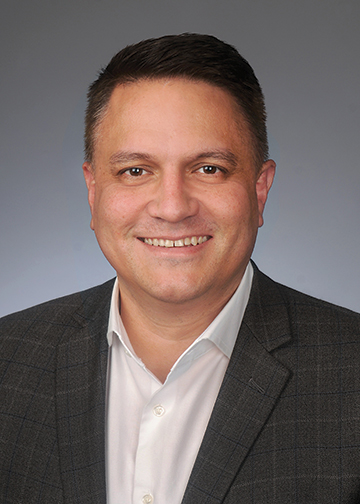As former chief information officer of San Francisco and chief technology officer of New York and now executive vice-president of global cities for Mastercard, Miguel Gamiño has had a view on “smart cities” – a term he insists should always be accompanied by the inverted commas given its sprawling and indefinable nature – from more angles than most. He tells EG how his plethora of roles stand him in good stead when it comes to understanding what makes a people-centric city.

You have such a varied career history. Which move was the biggest culture shock for you?
The more difficult, or perhaps I should say interesting, journey was going from start-up into government, rather than from public to private sector. I had all kinds of stereotypes in my head about what public service meant and what it might be like. In my start-up days, we actually wrote it into the business plan that we would not do business with government because I was so sceptical about its ability to move forward and make decisions.
What I learnt when I embarked on my civic duty and became CTO of El Paso, Texas, and then San Francisco and New York was that there were a lot of very talented people there who were really trying to do good with decisions that were very grave and very important.
In my start-up days, the worst-case scenario was that we would lose money. In the public sector, if these people made a decision that worked well then people’s lives would benefit. But if they didn’t then people’s lives would suffer. The gravity of that responsibility soaked in for me, and I became a different person with a different appreciation for public-sector life. Now I am at Mastercard, I wish the private sector had come to my office when I was in the public sector with the intent we are bringing now. The private sector really can be an enabler. It can help accomplish goals that city leaders are faced with.
You led tech strategies for three US cities. How did the roles vary?
My work for El Paso was all about making decisions to be efficient with investments and minimise the tax base. It really was all about efficiency, whether it was coming from technology or anything else, so it was pretty broad.
San Francisco was particularly interesting because it has this reputation of being the innovation capital. So I would read various media outlets ranking cities for innovation and we were always at the top because of venture capital investment. But I think it was misplaced.
We were getting a load of accolades and pats on the back just by virtue of being San Francisco and being in the right place at the right time. It was interesting tackling a digital strategy in a city that many would assume would already have one or would be technologically very advanced. The reality was that it was tough to get talent on board. Not because there wasn’t any, but because of the competition. There were a bunch of technologists around me that were doing great things that had nothing to do with decisions being made in City Hall. And we wanted them to be working for us. But we were up against some of the toughest competition as these guys were being hired by companies such as Uber. We had to motivate them to give up stock options in major tech companies, so we decided to sell purpose, kind of in lieu of stock options. We gave people the opportunity to have an impact and to make a difference. And it worked. We hired people away from Twitter, Amazon and Oracle because we gave them the opportunity to have a real impact.
In New York, I had the ability to make big decisions and mobilise big budgets. So we had the resource, but we really needed to engage the private sector to protect the legacy of the things we wanted to do for the greater social good.
New York really changed my perception of the relationship dynamics between the public sector and private sector. It wasn’t just about a transactional public-private partnership. It wasn’t just access to capital. It was really about if we agree on the positive social impact and we agree on it in a way that’s commercially viable then that impact will continue. It was authentic and very real in New York. And so that’s when I really began to have, I would say, an appropriate understanding and appreciation for the relationship between the public and private sectors.
Speaking of the relationship between the public and private sectors, let’s talk about your current role. You have moved to the private sector and you are heading Mastercard’s City Possible programme. What is that, and how does it work to bring global cities together?
City Possible is Mastercard’s strategy for engaging with cities in a meaningful way. I always get asked why Mastercard is in the city space, and the answer to that question is simple: every mayor I have either worked for or spoken with is trying to do the same thing.
They’re trying to make their community better by making it safer, more connected and better taxed, with improved transportation and education systems. And all those things are pointing towards the same end goal, which is to make the city healthier and more vibrant and give people access to opportunity. So, in short, we want to help mayors accomplish those goals.
The strategy creates this network of cities and partners to drive the discussion and surface the real challenges. Having the cities themselves identify that there is a mobility problem and that this problem is not unique but actually consistent across many cities is so helpful.
When I was a CTO and CIO, I remember thinking the city I was working for was the only one on the planet with the issues we were facing. And I think we all think we are the only ones, whether that’s a mayor or a city’s CTO. But it is very much the opposite. There is an 80:20 rule in my opinion across all cities. No matter what language you speak or what hemisphere you are in, 80% of the things you are trying to accomplish are the same worldwide. That remaining 20% may be bespoke to that particular jurisdiction, so the network we have created is really important because it might be that another city somewhere else doesn’t have that problem because they did, and they have already fixed it. So we need to mobilise this collaborative superpower to identify areas where we can share solutions that have been developed by other cities.
What is next for City Possible, and how has it been received by global cities?
In November last year, we announced that 16 cities had officially joined City Possible. I think we’re close to 25 cities now. That rise is significant because it is evidence that this is meaningful to cities – that they’re finding value in engaging – and so we want to scale that in 2019.
We want to have more cities join the network; we want to have them engage with each other around real face-to-face opportunities; and we want to give them the ability to share solutions digitally online and in some kind of a trusted venue online that we’re building.
We want to find those opportunities that we can develop solutions for, and we want to find a few of those that test out to be viable. Then we need to find ways to scale them globally. And that’s what we will be working on in 2019.
Over the course of your career and your roles in the start-up world – both public and private sector – what has been the most impactful moment so far?
There is one really important story for me – or rather the important part isn’t the story but the demonstration of the impact of something we did on the people living in the city.
This was in San Francisco, where part of what we did when I was working for the city was to roll out a public Wi-Fi service. This Wi-Fi included the public library where we happened to hold an event one evening. After the event, I was walking off the stage and a lady came up to me and thanked me for leaving the Wi-Fi on after the library closed at night. I sort of said thanks but wasn’t really sure why that was important as the library building was locked at night. I asked her to tell me more and I still get chills when I tell this part of the story. She said: “My son uses the Wi-Fi to do his homework in the library but sometimes isn’t finished before it closes, so he now sits outside the library if he needs more time to get it done each night.” I was simultaneously proud of what we had done with the roll out and ashamed that in the city of San Francisco that was the best we could do. So I guess the point is that some of these decisions we make that seem insignificant can impact people in a way that we could never have imagined. It moves you and it stays with you. And in the case of that kid and his homework, it drives you to do more.
To send feedback, e-mail emily.wright@egi.co.uk or tweet @EmilyW_9 or @estatesgazette











